The secret of the Stradivarius
According to experts, the Stradivarius are the best violins. They say that it has not been possible to do this type of violins. Eleven friends have sought the secret of these precious violins. Finally, it seems that a group of scientists have found the hidden element that gives the stradivarius its special tone.

A team of chemists from the University of Cambridge demonstrated with a special technique that Antonio Stradivarius rubbed his instruments with a layer of volcanic dust.
The Stradivarius studied the parts of a cello made in 1711 and found that under the orange red varnish layer there is another layer of volcanic dust of 50 microns. Until now it was thought that the hidden component of Stradivarius was in varnish. It has now been seen to be below.
A removed fragment of the cello was studied using a transmission electron microscope and found an unknown layer. In addition, the new analysis technique called EDAX (X-ray spectroscopy with energy diffusion) was analyzed. The sample is bombarded with high energy electrons. The sample then emits X-rays and by measuring the wavelengths of the rays the components can be fixed.
The material under varnish presented the characteristics of the minerals. Peaks of aluminum, silicon, phosphorus, sulfur, potassium, calcium, titanium, manganese and iron appeared. The presence of these peaks is due to a volcanic dust called puzolana. This dust is abundant in the region of Cremona, where Stradivarius lived. This is clearly seen in the spectra of the figure.
It is believed that Stradivarius, by dissolving the puzolana in the water and using an adhesive like the white egg, manufactured the mass that was rubbing in its instruments.
Puzolan is currently used to manufacture high quality cement. If mixed with lime, it gets a very tough material better than Portland cement.





